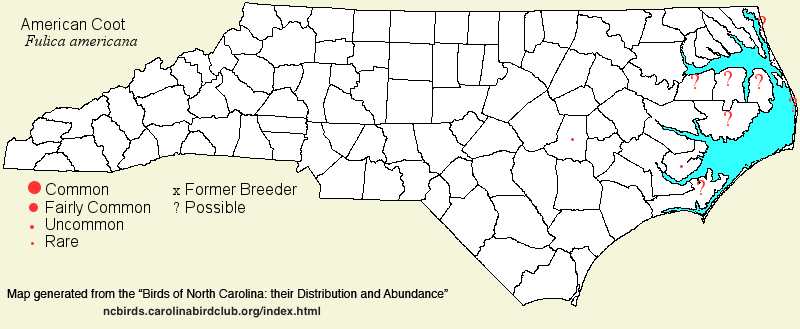 |  |
|
American Coot - Fulica americana RALLIDAE Members: | Search Common: Search Scientific: |
|
|
|||||||
| General Comments | The American Coot is one of the state's most familiar waterbirds, often occurring in large and dense flocks in migration and winter. However, the species does linger into summer occasionally, and on some occasions, birds do rear young, though, as with Purple Gallinule, and as with Common Gallinule well inland in the Coastal Plain, such nestings tend to be opportunistic or sporadic, with few if any consistent nesting sites. For breeding, coots occur in places similar to that for Common Gallinules -- freshwater ponds, lakes, or impoundments, but with marshy shorelines, and usually some floating or emergent vegetation amid the open water. In migration and winter, coots gather in often dense flocks to winter in various impoundments, lakes, and ponds, not necessarily with marshy shorelines; they can often be found far from shore, such as in the middle of Lake Mattamuskeet, as long as the lakes are shallow and birds can easily reach the bottom to feed on vegetation. Coots can also be seen walking and grazing on lawns and golf courses, as long as a body of water is nearby. Sadly, in the past few decades, the species has suffered locally serious declines -- owing to various diseases, to predation and disturbance by Bald Eagles, and perhaps to a decrease in aquatic vegetation. | ||||||
| Breeding Status | Accidental Breeder | ||||||
| NC BRC List | Definitive | ||||||
| State Status | |||||||
| U.S. Status | |||||||
| State Rank | SAB,S5N | ||||||
| Global Rank | G5 | ||||||
| Coastal Plain | Primarily a winter resident, but a sporadic breeder. Common to locally abundant in winter along the coast, and locally in Tidewater; farther inland, variously uncommon, to locally common, but not widespread, as suitable lakes and ponds are not common. Somewhat declining in recent years. Rare in midsummer, and casual to very rare breeder, mainly near the coast, but it has nested at Goldsboro on several occasions. First breeding reported at Pamlico Point impoundments in 1969. Primarily from mid-Sep to mid-May, but numerous records all summer. Peak counts: 13,855, Mattamuskeet NWR CBC, 29 Dec 2006; 10,000, West Onslow Beach, 23 Nov 1972; summer - 5 pairs produced 45 young at Goldsboro, summer 1988. | ||||||
| Piedmont | Winter resident, and accidental breeder. Variously uncommon (mainly in western portions) to locally common (some eastern portion lakes) in winter and migration; mainly mid-Oct to mid-Apr, though a number of summer records. Declining, often locally greatly so, in winter, especially where Bald Eagles are numerous; scarce in winter now in Wake, where formerly common. The only breeding records are from 2017 at Concord Mills (Cabarrus), where two adults were photographed with five juveniles on 27 Jun; and at this site in 2025 when a chick was with adults from 22-25 Jul. Peak counts: 3,100, Harris Lake (Wake), 17 Feb 2009; 3,000, Lake Wheeler (Wake), 12 Nov 1975. | ||||||
| Mountains | Mainly a transient, and scarce winter resident. Rare to uncommon migrant, and rather rare in winter, at low elevations; mainly mid-Oct into early May. Peak counts: ? | ||||||
| Finding Tips |
Coots should require no finding tips during the cooler months, at least near the coast at fresh water. They may be local farther inland, where they are clearly in decline. **** | ||||||
| Attribution | LeGrand[2025-10-20], LeGrand[2023-03-09], LeGrand[2018-02-01] | ||||||
| NC Map Map depicts all counties with a report (transient or resident) for the species. | Click on county for list of all known species. |
| NC Breeding Season Map Map depicts assumed breeding season abundance for the species. |  |